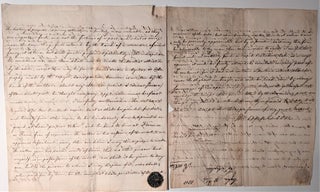Autograph Letter Signed to Thomas Aspinwall, Concerning Louis Bonaparte's Book.
Leghorn, Italy: September 28, 1818. Item #664 4to. 250 x 210 mm., [9 ¾ x 8 ½ inches]. 6pp., approximately 1000 words. Autograph letter signed, written in ink in very legible hand, folded. Remnants of an impressed seal, paper stock a bit browned, edges frayed, with a few small holes and cuts at folds all expertly reinforced with Japanese paper. Confidential and quite rare letter written by Thomas Appleton, U. S. Consul in Leghorn, Italy to Thomas Aspinwall, the American Consul in London requesting Aspinwall’s assistance in publishing the manuscript written by Louis Bonaparte entitled Documens historiques et réflexions sur le gouvernement de la Hollande. " I am in possession of the original manuscript which I have received from the hands of the author, a work of about 1800 pages...by the late King of Holland...it contains all the important events of his life, comprising all the documents relative to his reign...his letters to and from the Emperor Napoleon". Appleton expresses the importance of the work and how it will be avidly received by the world being "the most important work offered to the press during the revolution". Appleton cautions confidentiality repeatedly "although it does not contain a sentence that would cause the slightest umbrage" and says that Napoleon will pay for the printing, but that it may be advisable to try more than one printer "in order to excite a competition". The letter goes on to stipulate that the author requires “one hundred copies, such as shall be printed for sale and twenty-five other copies to be handsomely bound & printed on ‘grand, et beau papier velin’. . . The author gives his sacred word of honor, that on other person but myself is in possession of the work, nor shall it be given to any one, but to the person whom I may dispose of it, who shall when paid for by him, be the compleat & sole proprietor of this work.” It continues with mention of compensation to Aspinwall and other details The first edition of Louis Bonaparte’s three volume work appeared in Paris in 1820, followed quickly with editions printed in Ghent, Brussels, and Bruges, the same year. Thomas Appleton (1763-1840)was appointed by George Washington as the first U. S. Consul to Livorno Italy. He honed his skills as a diplomate in the 1780’s while living in Paris and associating with Thomas Jefferson, then Ambassador to France. He became a lifelong friend and correspondent of Jefferson and over the years acted as Jefferson’s agent in France and Italy. To supplement his income as consul general Appleton became an art dealer and was one of the first to ship sculpture and paintings to Boston and was instrumental in establishing a taste for the classical style of European for an American audience. Thomas Aspinwall (1786-1876), a Harvard lawyer, had been appointed consul to London by President James Madison, a position he held for 38 years from 1815 to 1853. His distinguished career was highlighted began with his participation in the War of 1812, where he lost an arm at the battle of Lake Eire and promoted to the rank of Colonel. He was also an important collector of Americana while in Europe and a catalogue of his collection was published in Paris in 1833. Much of the collection which included a Columbus Letter was purchased en-bloc by Samuel Barlow and can be found listed in the noted Bibliotheca Barlowiana published in 1864 and again in 1889. Napoleon proclaimed his brother, Louis, King of Holland in 1806. From the first, the emperor reproached him for being too easy on his subjects. By 1809 Napoleon was considering annexing Holland in order to arrest the trade the Dutch secretly conducted with England. In 1810, failing to negotiate successfully with either England or Louis, the Emperor dispatched French troops against the Dutch capital. Louis abdicated and fled his kingdom, which on July 9 Napoleon annexed to France. Styling himself the Comte de Saint-Leu, Louis lived for some time in Bohemia, Austria, and Switzerland. He spent his later life in Italy, largely occupied with literary pursuits. Carl Canon, American Book Collectors, pp. 66, 103. See biographical references to Appleton online-database American National Biography and for Aspinwall there is a short notice in Appleton’s Cyclopaedia of American Biography, I, p. 111.
Price: $750.00




